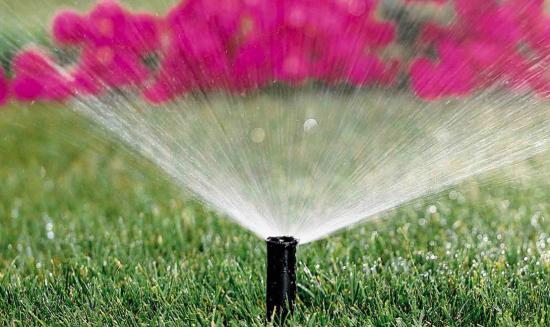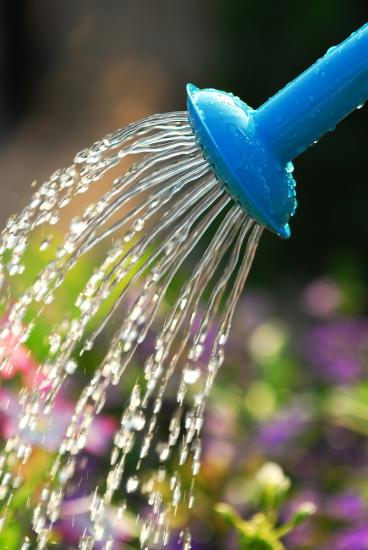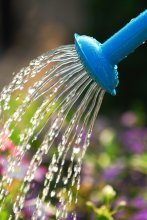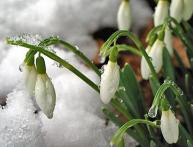How to water flowers correctly: basic rules

Watering is an integral part of caring for indoor plants. Quite often, flower growers make certain mistakes, which leads to their death. That's why before growing of a certain crop, it is necessary to determine: how to water flowers correctly?
Content:
Features of watering
To ensure active growth of the root system and foliage, proper watering is necessary. The frequency of this procedure is influenced by certain factors. First of all, this is the type of flower. Some of them need frequent watering, while others require infrequent watering. The frequency of the procedure is also affected by the season.
In most cases, flowers are watered much more often in summer than in winter. The need for watering in most cases is determined by the moisture level of the earthen ball in the pot. If the top layer soil dried out, then it is necessary to carry out the procedure. Appropriate water must be used for this purpose.
The use of hard water, which contains various salts, is strictly prohibited. That is why it is recommended to defend it before carrying out the procedure. If there is a need to soften the water, it is recommended to add a small amount of wood ash to it.

You can also add one hundred grams of fresh peat per 10 liters of water. You can also use special household filters to soften water.In some cases, special chemicals are used, which include oxalic acid.
Most indoor plants cannot tolerate water getting on their foliage. That is why it is recommended to use special dishes for watering. The ideal option in this case would be a watering can that has a long spout. If there is a need to remove dust from the foliage of a plant, you can put a special diffuser on the spout of the watering can. There are two types glaze - upper and lower.
In the first case, the procedure is carried out using a watering can. It is recommended to use a tray for bottom watering. Water is poured into it and a pot with a plant is installed. In this case, the flower will use as much water as it needs for full growth and development. The correctness of watering directly depends on the characteristics of the indoor flower and its requirements for the degree of humidity of the earthen clod.
Watering rules
In order for watering to have a beneficial effect on plants, it must be carried out in accordance with certain rules. In summer it is recommended to carry out the procedure in the evening, and in winter – in the morning. To avoid drying out of the root system, it is necessary to ensure good drainage in the pot. If during the watering period there is poor quality of water absorption, this indicates that the earthen ball has dried out.
In this case, the plant along with the pot is immersed in water, which will help soften soil. If the crop is grown in a ceramic container, it requires more frequent watering than in a plastic pot. If the room temperature rises, this requires more frequent watering.
The use of tap water is strictly prohibited. This is explained by the fact that lime, which is included in its composition, negatively affects the plant. It is best to use well-settled or filtered water. Before watering, it is imperative to check the drying level of the soil.
To avoid water getting on the foliage of plants, bottom watering is necessary. If the leaves of the flower need moisture, then spraying them is recommended. If the flower is exposed to solar radiation, then spraying is strictly prohibited.
Video on how to properly water flowers:
This is due to the possibility of sunburn. If water cannot pass through the top layer soil, then the soil is loosened. Compliance with all of the above rules will be the key to successfully growing indoor flowers.
Consequences of improper watering
If the procedure is carried out incorrectly, the soil may become waterlogged or dry out, which negatively affects the condition of the plant. In the first case, the leaves become limp and soft. Some areas may show signs of rot. Overwatering in most cases will slow down the growth of flowers.
The foliage of the plant may turn yellow and curl up.
It falls off quite often. The surface of the pot's soil may become moldy. If indoor flowers are not watered enough, the leaves become drooping and soft. The earthen lump is dry and hard. If the foliage of a plant is soft and tender, then a lack of moisture can cause it to wilt.
If the leaves of the flowers are hard, then insufficient watering leads to their drying out.If plants are rarely watered during the flowering period, this can lead to the fall of buds and flowers. Watering indoor flowers is quite a responsible procedure.

That is why it must be carried out in accordance with certain rules. This will ensure proper growth of the crop and limit the possibility of the emergence of various diseases.











Comments
I do not use bottom watering for my indoor plants, only top watering. I water violets this way too. The main thing is to have a watering can with a narrow spout. You can attach a narrow straw to the lid of a plastic bottle and water through it. When watering in a tray, it seems to me that there is a greater risk of root rot.
But I prefer rare and abundant watering, sometimes I put the pot in a basin so that the earth is first saturated with moisture, and then in the bath so that excess water drains, I also drain excess water from the pan, although there is always drainage in pots.
It seems to me that it is better to underwater than to overwater. Since many plants like moderate watering as the soil dries out. In addition to watering, I also spray indoor plants. Leaves also need moisture.
Each flower requires its own characteristics in watering; some plants do not tolerate heavy watering, others are better off not getting it on the leaves. I treat each flower individually and know their needs.
When watering indoor plants, it is also important to consider what kind of pot the flower is growing in; for example, in natural clay pots the soil dries out faster, so you need to water them more often.